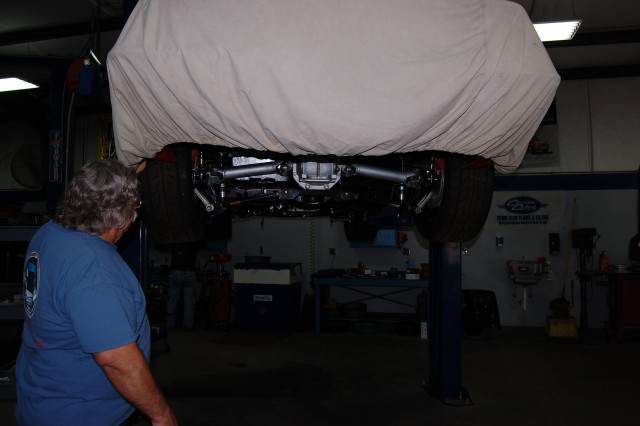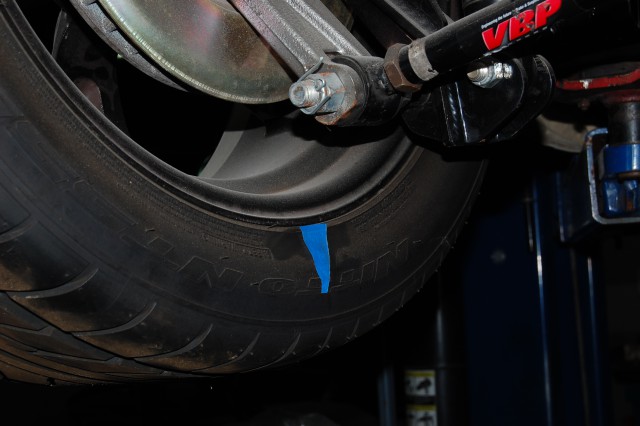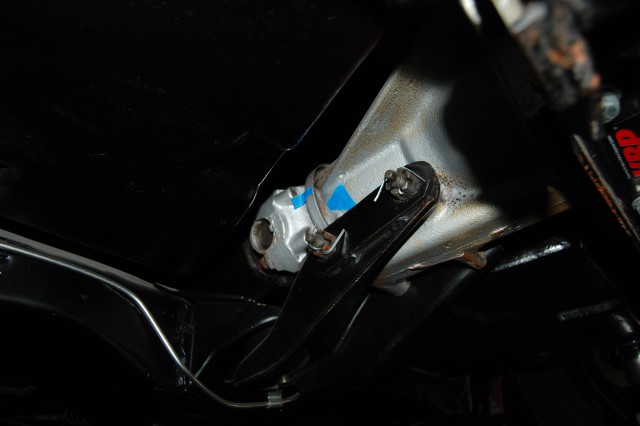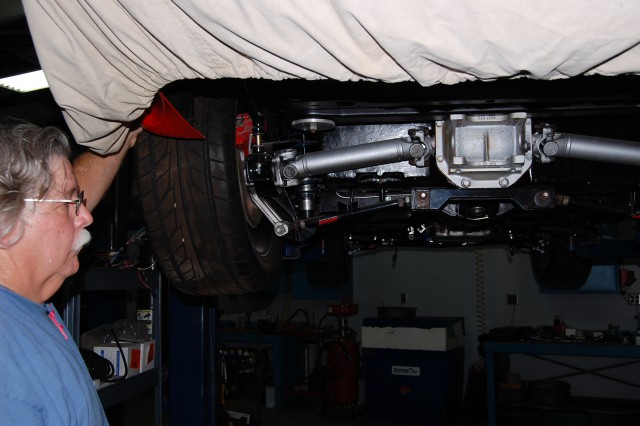Have you always thought about how the correct rear axle ratio affects your Corvette's operation? First, acquire what ratio you have hidden away in the differential housing. Early Corvettes (1960-1970) may have many different ratios; later Corvettes had fewer choices, in an effort to boost fuel mileage, and past the mid-80s performance gear ratio options were rare.
Enhance the rear of your Corvette so both wheels spin freely. You need a jack and stands, or a lift if you lot are lucky. Be extra careful when lifting whatsoever vehicle. If using a floor jack, make certain the front wheels curl as the jack lifts the back cease. Place wheel chocks at the front tires to prevent rolling forward. As the jack lifts, your Corvette has to roll back towards you lot as the distance becomes shorter.

In one case in the air, stands should be placed nether the frame or trailing artillery as protection from jack failure. When your Corvette is deeply lowered, rear beam ratio tin can be safely determined. The transmission must be in neutral with the parking brake off. The objective is to count how many times the driveshaft rotates as the wheel makes i total rotation. Mark the driveshaft near the differential housing (normally the yoke) and make a mark on the differential housing. Mark the tire so you can decide when 1 full rotation has taken place.

FYI – your Corvette must be equipped with a posi-traction differential for the above procedure to work.

Early on Corvettes without posi-traction will crave a slightly different approach; merely the bike should be upwardly off the ground, rotating freely. Use the aforementioned procedure as in a higher place to safely raise and back up your Corvette. The free spinning wheel has to be rotated two full turns while counting how many times the driveshaft rotates. This is due to the differential pinion gears rotating inside the differential. You lot tin use the aforementioned process as the posi-traction equipped Corvette although information technology is difficult and an error can easily occur. You would crave a helper and both wheels must rotate in unison while someone counts the driveshaft rotations.

The equation is simple. If the driveshaft yoke rotates a bit by 4 turns during one full wheel rotation, you would have a 4.11 rear gear ratio. Divide the driveshaft rotations into ane [4.eleven / 1]. Non posi-traction Corvettes use the aforementioned formula, counting ii revolutions of the cycle while using 1 as the divisor.
What do the numbers mean?
Numerically depression gear ratio numbers (iii.08, for instance) mean more power/torque is required to motility your Corvette. One time rolling, the 3.08 gear ratio volition keep your engine rpm depression and help save fuel. On the flip side, starting line performance suffers. Loftier numerical gear ratios (4.eleven) have a greater mechanical advantage, requiring less power (torque) to get you rolling. The downside is engine rpm increases at highway speeds as fuel flows rapidly out of your tank.
Wheel/tire diameter also plays an important part in the rear gear ratio equation. Installing a taller tire lowers the mechanical advantage, requiring less rpm to maintain the same speed as the original equipment tire diameter. This affects acceleration performance negatively while increasing top stop speed.
Practise I Really Care if I Have a Low or Loftier Gear Ratio?
Yes, if overall performance is of import to you and particularly if you lot're planning whatsoever performance modifications. The near powerful engine volition feel sluggish with the incorrect rear axle gear ratio. In some cases, the rear axle gear ratio should be left alone and a transmission change may exist the right direction to have. Some contrary situations arise when dealing with mechanical components, including the driveline. Let me expand on what driveline situations you might be upwards against.
Overdrive Transmission or Rear Axle Gear Ratio Change?
Overdrive manual is a great innovation. Early, overdrive transmissions were marketed with poor results. No one was concerned with fuel mileage. Today, overdrive transmission is considered standard equipment. Withal, many early Corvette restorers are reluctant to brand this modification. Not only practice you slow the engine down at highway speed, many overdrive units have a better first gear ratio for more starting line performance.
This means y'all also need to consider the manual'southward gear ratios for best possible driveline functioning. In some cases, changing the transmission to an overdrive unit can aid off-the-line performance and save fuel while cruising. Where am I going with this? Take time to clarify what yous have to piece of work with. You may be surprised to find not much engine work is required to proceeds the desired performance.
I know in that location is never enough performance, but this volition transport you downwards the correct path to go all you can.
Chemical compound/Combined Gearing
Let's review how the rear axle gear ratio works in conjunction with the manual. All Corvettes built earlier 1981 had 1-1 manual concluding drive gear ratios. This is the prime example of how an overdrive manual change would benefit: 1969 Corvette with an original Muncie M20 that has a two.52 first gear ratio with a three.36 rear axle gear ratio. Our combined start gear ratio would exist [3.36 x 2.52 = 8.46], not too bad for a 427 cubic inch engine with plenty of depression rpm torque. A low torque 327 cubic inch engine would not be very exciting to drive until yous got above 35-40 mph.
Changing to a Tremec TKO 500 manual transmission—which has a 3.27 outset gear ratio and .68 overdrive ratio—would make this the perfect for functioning and cruising. The iii.36 rear axle gear ratio coupled with the 3.27 transmission first gear ratio multiplies providing a 10.98 commencement gear ratio [3.36 x three.27 = ten.98]. That 10.98 combined gear ratio will brand even a smog motor small block Chevy experience good.
If you went the other style and inverse the rear beam ratio, the engine would scream—4000 rpm at 75 mph with a 4.eleven rear gear axle ratio, adding extra wear to the engine and to your mental country. The combined gear ratios [4.11 ten 2.52 = 10.35] would provide decent off-the-line operation, even with a low horsepower engine. This is why it makes sense to evaluate what you are working with before making any driveline changes, including engine performance.
Tremec also has a TKO 600 five speed overdrive transmission available with a 2.87 showtime gear ratio. This might be used in engines that produce loftier torque at low rpm (big blocks or large cubic inch small blocks). Using a 3.90 rear axle gear ratio every bit an example [two.87 ten 3.xc = xi.19], this is on the high side for a high torque engine. A iii.36 rear axle gear ratio would exist more livable [3.36 10 2.87 = 9.64]. Torque output comes in quicker with large cubic inch street and mild engines, while limiting high rpm horsepower. Now there are large cubic inch race engines that make good torque and horsepower at higher numbers. That is some other article in itself.
Choosing a TKO 500 five speed overdrive transmission for a large cubic engine would require rear axle gear ratios in the high-mid twos. The TKOs iii.27 first gear [three.27 x 2.73= 8.92] makes practiced apply of a large cubic inch engine's torque. If a iii.fifty rear axle gear ratio was used, first gear starts would be very short lived; great for a heavy duty truck with a x,000 pound gross vehicle weight.
Automatic Manual Torque Converters also play into the Equation
Torque converters are more than a slipping clutch to terminate your Corvette at the calorie-free without taking the transmission out of gear. Torque converters multiply torque to move the vehicle's weight. Typical torque conversion is a ii:1 multiplication rate. If your engine is producing 250 foot pounds of torque, it would be in the 500 human foot pound range equally the torque converter approaches stall speed. That means the same rear beam gear ratio with an automatic transmission would assist you leave the stoplight quicker.
As far every bit automatic manual first gear ratios are concerned, the list below covers all manufacturing plant equipped automatics. 4L60 and 4L60E have .70 overdrive gear ratio. The same formulas use for the automatic gear ratios concerning the combined ratio. The beauty is in the converter's torque multiplication.
TH350 2.52
TH400 two.48
700R4 or 4L60 3.06
4L60E 3.06
An automatic Corvette could potentially accept a better launch than a manual. Automated transmissions are also easier on the drivetrain, fugitive the shock loading when the clutch is released quickly on transmission transmissions.
Y'all can look improved functioning from a rear axle gear ratio change on 1982 and up Corvettes equipped with overdrive transmissions.
When fuel mileage standards were raised, auto manufacturers decided an overdrive manual was the easiest mode to comply. In an endeavour to increase the fuel mileage even further, high mechanical reward rear axle ratios were used. It was common to discover 3.08 and lower rear axle gear ratios in 1982 and older vehicles. 1984 Corvette Crossfires took full reward of this technology with three.07-3.31 rear axle gear ratios and an engine that ran out of power at 4000 rpm due to the restrictive intake manifold.
By 1985-1991, the L98 Tuned Port Injection was introduced with excellent torque at depression engine rpm, although horsepower faded higher up 4500 rpm. This required a bourgeois rear axle gear ratio choice. Later, when LT1, LT4, and LS series engines were introduced, engine torque and horsepower levels increased. There was no longer a need for ii.50 or 2.73 rear axle gear ratios to take advantage of the L98 Tuned Port engine's torque.
A bully example is an early on 90s L98 engine with 2.59 rear axle ratio. Changing to a 3.50 rear axle gear ratio makes them feel like they gained 50 horsepower. Now the same 90s Corvette does not do as well with a 4.11 rear beam gear ratio, unless you plan to run full throttle stoplight to stoplight. This is how gear ratios make a direct impact on vehicle driveline performance.
Let's Wrap it Up
At present that we know how driveline ratios play into overall operation, let's embrace how important it is to match engine torque curve to gear ratios. Camshaft specification predicates torque curve rpm ring. A typical early Corvette engine has torque/horsepower band in the 2000-5500 range. To sum things up, large cubic inch engines tend to have more torque at lower rpm, performing improve with lower combined gear ratios. Small cubic engines crave more rpm before torque builds, requiring college combined gear ratios.
All too often, I see owners who are disappointed with poor performance later on major high performance engine piece of work has been completed. Almost of the time, likewise much camshaft duration and incorrect combination of gear ratios are to arraign.
Always consider what type of driving you expect to practice. If you're drag racing, the rear axle ratio should exist iii.xc or higher. Everyday cruiser rear axle gear ratios tend to be less aggressive, in the iii.fifty or lower range. Time to do the calculations!
1953-1967 Rear Beam Ratios & Identification Codes
| Code | Ratio | Blazon | Application |
|---|---|---|---|
| 1953 | |||
| LW | iii.55:1 | Standard | Early |
| MW | three.55:ane | Standard | Belatedly |
| 1954 | |||
| MW | 3.55:i | Standard | All |
| 1955 | |||
| AE | 3.55:1 | Standard | Powerglide |
| AH | iii.55:i | Standard | 3-Speed |
| AD | 3.27:i* | Standard | three-Speed |
| *May not accept been used on the 1955 Corvette | |||
| 1956 | |||
| AE | 3.55:ane | Standard | Powerglide |
| AH | 3.seventy:one | Standard | 3-Speed |
| AD | three.27:one | Standard | 3-Speed |
| AJ | four.eleven:1 | Standard | 3-Speed |
| Notation: A very few 1956 Corvettes used Positration Rear Axles stamped "3.seventy.xi HT" or "4.56.1HT" indicating gear ratio and Hello-Tork. | |||
| 1957-1958 | |||
| AE | three.36:1 | Standard | Powerglide |
| AH | 3.70:1 | Standard | Manual Manual |
| AN | three.seventy:1 | Positraction | Manual Transmission |
| AP | four.11:one | Positraction | Transmission Manual |
| AQ | four.56:i | Positraction | Manual Transmission |
| Every bit | 3.70:ane | Positraction | Transmission Trans. & H.D. Brakes & Suspension |
| AT | 4.eleven:ane | Positraction | Manual Trans. & H.D. Brakes & Suspension |
| AU | 4.56:one | Positraction | Manual Trans. & H.D. Brakes & Suspension |
| 1959-1960 | |||
| AE | 3.55:ane | Standard | Powerglide |
| AH | iii.seventy:ane | Standard | Manual Transmission |
| AN | 3.70:1 | Positraction | Transmission Transmission |
| AP | four.11:1 | Positraction | Manual Transmission |
| AQ | four.56:1 | Positraction | Manual Transmission |
| As | three.70:i | Positraction | Manual Trans. & H.D. Brakes & Suspension |
| AT | 4.eleven:i | Positraction | Transmission Trans. & H.D. Brakes & Suspension |
| AU | 4.56:1 | Positraction | Transmission Trans. & H.D. Brakes & Suspension |
| FJ | 3.seventy:1 | Standard | Manual Trans. & Metallic Brakes |
| FK | 3.lxx:1 | Positraction | Manual Trans. & Metal Brakes |
| FL | iv.eleven:ane | Positraction | Manual Trans. & Metallic Brakes |
| FM | 4.56:1 | Positraction | Transmission Trans. & Metallic Brakes |
| 1961 | |||
| Air conditioning | 3.36:1 | Standard | 3-Speed |
| AE | iii.55:1 | Standard | Powerglide |
| AH | 3.70:1 | Standard | 4-Speed |
| AN | 3.70:ane | Positraction | Manual Manual |
| AP | 4.11:1 | Positraction | Manual Manual |
| AQ | four.56:1 | Positraction | Manual Transmission |
| AF | 3.36:1 | Positraction | Manual Manual |
| As | three.70:i | Positraction | 4-Speed & H. D. Brakes & Pause |
| AT | 4.xi:1 | Positraction | Manual Trans. & H. D. Brakes & Interruption |
| AU | iv.56:1 | Positraction | Manual Trans. & H. D. Brakes & Suspension |
| FJ | three.70:i | Standard | 4-Speed & Metallic Brakes |
| FK | 3.70:1 | Positraction | 4-Speed & Metallic Brakes |
| FL | 4.11:1 | Positraction | Manual Trans. & Metallic Brakes |
| FM | 4.56:1 | Positraction | Manual Trans. & Metallic Brakes |
| 1962 | |||
| CA | iii.36:one | Standard | Manual Transmission or Powerglide |
| CB | iii.36:i | Positraction | Transmission Transmission or Powerglide |
| CC | 3.55:i | Positraction | four-Speed |
| CD | 3.70:1 | Positraction | 4-Speed |
| CE | 4.11:1 | Positraction | 4-Speed |
| CF | four.56:1 | Positraction | 4-Speed |
| CG | 3.70:1 | Standard | 4-Speed |
| CX* | three.70:i | Standard | Shut-Ratio 4-Speed |
| CH | 3.36:one | Standard | Manual Trans. & Metal Brakes |
| CY | three.seventy:i | Standard | iv-Speed & Metallic Brakes |
| CK | 3.36:1 | Positraction | 4-Speed & Metallic Brakes |
| CL | 3.55:ane | Positraction | 4-Speed & Metallic Brakes |
| CM | 3.40:i | Positraction | 4-Speed & Metallic Brakes |
| CN | 4.11:ane | Positraction | four-Speed & Metallic Brakes |
| CP | 4.56:one | Positraction | four-Speed & Metallic Brakes |
| CQ | three.seventy:1 | Positraction | 4-Speed & H. D. Brakes & Pause |
| CR | 4.11:1 | Positraction | iv-Speed & H.D. Brakes & Break |
| CS | 4.56:1 | Positraction | iv-Speed & H.D. Brakes & Suspension |
| CT | three.08:i | Standard | iv-Speed |
| CU | 3.08:ane | Positraction | four-Speed |
| CV | 3.08:one | Standard | 4-Speed & Metal Brakes |
| CW | 3.08:1 | Positraction | 4-Speed & Metallic Brakes |
| *1962 "CX" Code Unverified | |||
| 1963-1964 | |||
| CA | 3.36:1 | Standard | Transmission Transmission or Powerglide |
| CB | 3.36:i | Positraction | Manual Transmission or Powerglide |
| CC | 3.55:1 | Positraction | 4-Speed |
| CD | 3.70:1 | Positraction | 4-Speed |
| CE | 4.11:1 | Positraction | 4-Speed |
| CF | 4.56:one | Positraction | 4-Speed |
| CJ | 3.08:i | Positraction | 4-Speed |
| CX | 3.70:1 | Standard | Shut-Ratio 4-Speed |
| CZ | 3.08:1 | Standard | Wide-Ratio four-Speed |
| 1965-1967 | |||
| AK | 3.36:one | Standard | Manual Transmission or Powerglide (327) |
| AL | 3.08:1 | Positraction | 4-Speed (327) |
| AM | iii.36:1 | Positraction | Manual Transmission (327) |
| AN | iii.55:1 | Positraction | 4-Speed (327) |
| AO | iii.seventy:1 | Positraction | 4-Speed (327) |
| AP | four.11:1 | Positraction | four-Speed (327) |
| AQ* | iv.56:one | Positraction | 4-Speed (327) |
| AR* | 3.08:1 | Standard | Wide-Ratio 4-Speed (327) |
| AS | iii.70:ane | Standard | Close-Ratio 4-Speed (327) |
| AT | 3.08:1 | Positraction | 4-Speed (396/427) |
| AU | iii.36:i | Positraction | iv-Speed (396/427) |
| AZ | three.55:i | Positraction | 4-Speed (396/427) |
| FA | three.lxx:1 | Positraction | 4-Speed (396/427) |
| FB | 4.eleven:ane | Positraction | 4-Speed (396/427) |
| FC | iv.56:i | Positraction | 4-Speed (396/427) |
| NOTE: All 1965-167 Corvette Rear Axles were manufactured at Warren and are suffixed "W". | |||
| *Listed 1967 "AQ" and "AR" codes & ratios may simply have been used early in the 1967 model-twelvemonth, or not at all. | |||
| 1968-1969 | |||
| AK | 3.36:1 | Standard (327/350) | |
| AL | iii.08:one | Positraction (327/350) | |
| AM | three.36:1 | Positraction (327/350) | |
| AN | 3.55:one | Positraction (327/350) | |
| AO | 3.70:1 | Positraction (327/350) | |
| AP | 4.xi:1 | Positraction (327/350) | |
| Every bit | iii.seventy:1 | Standard (327/350) | |
| AT | 3.08:ane | Heavy Duty Positraction (427) | |
| AU | 3.36:1 | Heavy Duty Positraction (427) | |
| AV | iii.08:1 | Positraction (427) | |
| AW | 3.08:ane | Heavy Duty Positraction (427) | |
| AY | 2.73:one | Heavy Duty Positraction (427 Turbo Hydra-Matic) | |
| AZ | 3.55:1 | Heavy Duty Positraction (427) | |
| FA | three.70:1 | Heavy Duty Positraction (427) | |
| FB | 4.11:1 | Heavy Duty Positraction (427) | |
| FC | 4.56:1 | Heavy Duty Positraction (427) | |
| NOTE: 1968-69 Corvette Rear Axles were manufactured at Warren and are suffixed "W". 1969 models congenital afterwards approximately August of 1969 use 1970 coded rear axles. | |||
| 1970 (Late 1969) | |||
| CAK | 3.36:1 | Standard | |
| CAL | 3.08:1 | Standard | |
| CAM | iii.36:ane | Positraction | |
| CAN | 3.55:1 | Standard | |
| CAO | 3.lxx:1 | Positraction | |
| CAP | four.xi:1 | Standard | |
| CAS | 3.lxx:1 | Standard (LT1) | |
| CAT | 3.08:1 | Heavy Duty Positraction | |
| CAU | 3.36:1 | Heavy Duty Positraction | |
| CAV | 3.08:1 | Standard | |
| CAW | iii.08:ane | Standard | |
| CAX | three.36:i | Heavy Duty Positraction | |
| CAY | 2.73:1 | Positraction (454 Turbo Hydra-Matic) | |
| CAZ | 3.55:1 | Heavy Duty Positraction | |
| CFA | three.70:ane | Positraction | |
| CFB | four.11:i | Heavy Duty Positraction | |
| CFC | 4.56:1 | Heavy Duty Positraction | |
| CLR | 3.36:i | Standard | |
| Notation: Positraction became standard equipment on the 1970 Corvette and the inclusion of Not-Positraction (standard) beam codes by Chevrolet is in disharmonize | |||
| 1971 | |||
| AA | 3.55:one | ||
| AB | 3.seventy:1 | ||
| Air-conditioning | four.11:1 | ||
| Advert | 4.56:1 | ||
| AW | 3.08:1 | ||
| AX | 3.36:i | ||
| LR | iii.36:ane | ||
| 1972 | |||
| AA | 3.55:ane | ||
| AB | 3.70:1 | ||
| AC | four.eleven:1 | ||
| AX | 3.36:ane | ||
| LR | 3.36:1 | ||
| 1973-1974 | |||
| AA | 3.55:1 | ||
| AB | 3.seventy:ane | ||
| AC | four.11:1 | ||
| AW | three.08:1 | ||
| AX | three.36:ane | ||
| LR | 3.36:ane | ||
| 1975 | |||
| AA | three.55:i | ||
| AB | iii.seventy:1 | ||
| Air conditioning | 4.xi:1 | ||
| AY | 2.73:i | ||
| AW | iii.08:1 | ||
| AX | 3.36:1 | ||
| LR | 3.36:i | ||
| 1976-1977 | |||
| OA | three.08:ane | ||
| OD | 3.36:1 | ||
| LR | iii.36:1 | ||
| OB | 3.55:1 | ||
| OC | three.70:1 | ||
| 1978 | |||
| OK | three.08:i | ||
| OM | three.36:1 | ||
| OH | 3.55:1 | ||
| OJ | three.seventy:1 | ||
| 1979 | |||
| OM | three.36:ane | ||
| OH | three.55:1 | ||
| OJ | 3.lxx:1 | ||
| 1980 | |||
| OF | iii.07:1 | ||
| OH | three.07:one | ||
| 1981 | |||
| OJ | 2.87:one | Automated Transmission | |
| OK | 2.72:1 | Manual Transmission | |
| 1982 | |||
| OA | 2.72:one | Standard Wheels | |
| OF | 2.87:1 | Aluminum Wheels | |
| Annotation: All 1970-1982 Corvette Rear Axles were Positraction | |||
| C4 | |||
| GHO | 3.54 | ||
| GM1 | 2.59 | Rear Axle | |
| GM3 | 3.45 | Rear Axle | |
| GT7 | iii.33 | Rear Beam | |
| GU2 | 2.73 | Rear Axle | |
| GW4 | three.31 | Rear Axle | |
| HE3 | 3.07 (1984) | Rear Axle | |
| G44 | three.07 (1985) | Rear Axle | |
| GUU | iii.07 (1986-1996) | Rear Axle | |
Story and photos courtesy Chris Petris
Sign upward for our email newsletter featuring tech articles, coupon codes, news, contests, events and more!
